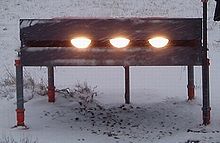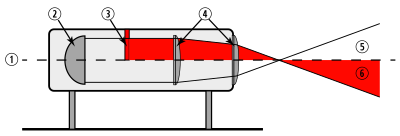VASI
The VASI (Visual Approach Slope Indicator) is an optical system that supports pilots in maintaining the glide path when approaching a runway and simplifies approaches at night. The system is characterized above all by its ease of use, but is dependent on sufficient flight visibility. A VASI in accordance with ICAO Annex 14 Chapter 5.3.5 is only required for airfields if one of five points from Annex 14 ( e.g. use of the airfield by turbo jets or higher and IFR approach procedures) is met, otherwise a VASI system is required not mandatory.
VASI - Visual Approach Slope Indicator
The VASI consists of two units with two light bars each (it is therefore also called two-bar VASI), which signal either red or white, depending on the pilot's altitude. The first unit is at the beginning of the taxiway, the second unit is a few meters behind it. Each light bar consists of three lights (see picture). The colors are not actively changed, the pilot only sees the VASI in different colors depending on the elevation angle to the lights. VASI specifies a glide path in a range of 10 ° down and up from the glide path and extends up to 6.5 km.
The way it works is simple: If the pilot flies too low, below the correct glide path, VASI signals a red-over-red combination. The correct glide path is shown in red over white. If, on the other hand, the pilot flies too high, he sees a white-over-white combination.
There are four joking mnemonics common among pilots:
- "Red over red, you'll clonk / lose your head" (red over red and you'll soon be dead.)
- "Red over white, you're alright" (red over white, first price.)
- "White over white, you'll soon be out of sight" (White over white and you land in the corn.)
- "Four time red you flight in your death." (Four times red you fly to death.)
In addition to the two-bar VASI, there is also a three-bar VASI, which is mainly to be found at airports that fly to several aircraft classes. In principle, you simply combine two VASI systems into one, whereby a high glideslope (3.25 °, HG) and a low glideslope (3 °, LG) are displayed. The lower VASI bar is then simply ignored for the HG and the upper VASI bar for the LG.
The third VASI is the Pulsating VASI, which only consists of one VASI unit. If the pilot is on his glide path, a white light is visible. If the approach is too high, the white light begins to pulsate. An approach that is too low is indicated by a continuous red light, and a pulsating red light means that the altitude is far too low, so you are extremely under your glide path.
The last member of the VASI family is the three-color VASI. A yellow signal is displayed above the glide path, green on the glide path, and an approach that is too deep is shown in red.
PAPI - Precision Approach Path Indicator
PAPI, in German "Precision approach glide angle lights", is another form of the VASI. There is only one unit here, which contains four lights. These lights are arranged next to each other, but basically work like a VASI. The PAPI shows all four lights in red when the approach angle is less than 2 degrees 30 minutes. With an approach between 2 degrees 30 minutes to 2 degrees 50 minutes you see 3 red / 1 white, between 2 degrees 50 minutes to 3 degrees 10 minutes you see 2 red / 2 white, between 3 degrees 10 minutes and 3 degrees 30 minutes one red / 3 white lights. An approach too high - above 3 degrees 30 minutes - is signaled by four white lights (without harmonization with an ILS . If an ILS is present, the angle settings are slightly changed). The PAPI is intended as a visual aid only up to a height of 200 ft above the threshold.
The PAPI systems are switched off during CAT II / III approaches .
APAPI - Abbreviated Precision Approach Path Indicator
APAPI is a simplified form of the PAPI that only contains two lights arranged next to each other. A correct approach angle is indicated by a red and a white light. Two red lights mean that the approach is too flat, two white lights mean that the approach is too steep. This system is very similar to VASI.
See also
literature
- Jeppesen Sanderson - Privat Pilot Manual 2001, ISBN 0-88487-238-6
- Lufthansa Flight Training, Pilot School, BRE OS1 / A - International Air Traffic Regulations and Procedures , 2003




